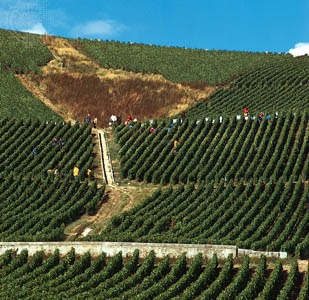Champagne-Ardenne
region, France
 région of France encompassing the northern départements of Haute-Marne, Aube, Marne, and Ardennes and roughly coextensive with the historical province of Champagne. Champagne-Ardenne is bounded by the régions of Lorraine to the east, Franche-Comté to the southeast, Burgundy (Bourgogne) to the south, and Île-de-France and Picardy (Picardie) to the west. The country of Belgium lies to the north. The capital is Châlons-en-Champagne.
région of France encompassing the northern départements of Haute-Marne, Aube, Marne, and Ardennes and roughly coextensive with the historical province of Champagne. Champagne-Ardenne is bounded by the régions of Lorraine to the east, Franche-Comté to the southeast, Burgundy (Bourgogne) to the south, and Île-de-France and Picardy (Picardie) to the west. The country of Belgium lies to the north. The capital is Châlons-en-Champagne.In the south of the région lies the Langres Plateau, which reaches elevations of more than 1,500 feet (450 metres). This and other limestone highlands in the département of Haute-Marne are among the most heavily forested areas of France. Farther west, the dry chalk platform of Champagne-Ardenne is traversed (southeast-northwest) by the converging Aube and Seine river valleys, which cut through Côte des Bars, a region of scarped limestone hills. The rugged Argonne Massif lies in the northern part of the région and is drained by the Aisne River. Other important rivers include the Meuse and the Marne.
The région is sparsely populated. As in much of nonurban France in the 20th century, the population decreased by more than one-sixth between 1901 and 1946, largely because of emigration to Paris and to Lorraine for employment in the steel and coal industries. Population grew after World War II, but at a rate below the national average, and by the end of the century growth had flattened as a result of new out-migration.
Champagne-Ardenne is a rich agricultural region in which farms (particularly on the chalk plains) are large, capital-intensive, and highly mechanized. Cereals (especially wheat and barley) are widely cultivated, and other major crops include alfalfa, sugar beets, legumes, and oleaginous plants such as rapeseed. Large quantities of champagne and table wine are produced annually. The champagne industry is of great importance around Reims and Épernay, where it is a major employer. Dom Pierre Pérignon (1638–1715), who discovered how to make champagne sparkle, was born just east of Épernay in Sainte-Menehould. Afforestation, necessitated by centuries of small-industrial and domestic overcutting, was undertaken during the 19th century.
Traditional industries, now in decline, include textiles in the Meuse valley and around Troyes. Metalworking concentrated in the départements of Ardennes and Haute-Marne is also less important than it once was. Newer industries are automobile components, plastics, and food and beverage processing. The région's chemical, glass, packaging, and printing industries are directly related to the needs of the champagne producers. Nuclear power stations have been built in Ardennes and Aube.
 Among the tourist destinations in the Champagne-Ardenne are the 13th-century Reims Cathedral, one of the most beautiful Gothic churches in France; the basilica of l'Epine; and the fortified city of Langres, parts of which date back to the 2nd century. Accessibility has been greatly improved by a series of motorways that now traverse the région.
Among the tourist destinations in the Champagne-Ardenne are the 13th-century Reims Cathedral, one of the most beautiful Gothic churches in France; the basilica of l'Epine; and the fortified city of Langres, parts of which date back to the 2nd century. Accessibility has been greatly improved by a series of motorways that now traverse the région.Historically, Champagne-Ardenne is noted as the scene of many battles since the French Revolution, including those in the campaign of 1794 and the Franco-German War, the Battle of the Ardennes in World War I, and the Battle of the Bulge, the final offensive action in France by the Germans in December 1944. Area 9,887 square miles (25,606 square km). Pop. (1999) 1,342,363; (2006 est.) 1,339,000.
- broken rhyme
- Brokopondo
- Brome, Alexander
- bromegrass
- bromeliad
- Brome, Richard
- Bromfield, Louis
- bromine
- Bromley
- Bromsgrove
- 'Brom-ston
- bronchiectasis
- bronchitis
- Brongniart, Adolphe-Théodore
- Brongniart, Alexandre
- Broniewski, Władysław
- Bronisław Malinowski
- Bronko Nagurski
- Bronowski, Jacob
- Bronsart von Schellendorf, Paul
- Bronson Alcott
- Bronson, Charles
- Bronson Howard
- Bronte
- brontothere